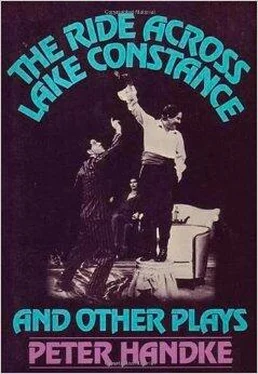During the period without movement we just listen to the music. Now the music becomes nearly inaudible, just as the main theme may disappear almost entirely during certain sections of a film.
We see the warden slowly place his forearms on the table.
In reply to this movement, the ward places his hands on the table, fingertips pointing at the warden.
The warden, without looking at the ward, slowly places his head on his forearms, on his hands, actually, and in such a way that his mouth and nose are placed on the backs of his hands, with his eyes looking across them.
Thereupon the ward slowly lowers his head toward the table until his head is hanging between his arms at the height of the table. After pausing briefly in this position and at this level, the ward lowers his head even further, down between his outstretched arms, which he has to bend now, until his head almost touches his knees: the ward remains in that position.
The warden draws his head toward himself until it lies, not with his mouth and nose, but with his forehead on his hands.
The ward spreads his knees and sticks his head deeper down between his bent arms and spread knees.
The warden pulls his hands out from under his head and now lies with his bare face, that is, with his bare mask, on the table.
(All these movements, although they occur very slowly, are not ceremonial.)
The ward lets his arms drop from the table but leaves his head hanging between his knees at the previous level.
The warden, while keeping his face in the previous position, uses his body to push the chair as far away from the table as possible, while still keeping his face on the table, his body slipping from the chair.
The ward, if possible, clenches his knees together above his head or against it.
Both of them are completely quiet onstage, as if no one were watching.
We hear the music somewhat more distinctly.
Some time passes; it has already passed.
The objects are in their places, here and there.
The warden stands up, without our noticing the in-between movements; he stands there, he represents standing, nothing else.
What will the ward do now?
Some time passes; we wait.
Now the ward sits up, without our particularly noticing the in-between movements.
What is the warden doing? He walks about the stage and represents walking.
The ward gets up; he stands there.
The warden runs; the ward begins to walk.
The warden leaps; the ward begins to …
The warden climbs up on a chair and is now standing on it; the ward does not leap but stops in his tracks and stands there.
The warden climbs on the table; the ward climbs on the chair.
The warden takes the other chair and puts it on the table and climbs on the chair on the table; the ward — how could it be otherwise? — climbs on the table.
The warden grabs on to a rope hanging down and hangs there; the ward climbs on the chair on the table.
The warden is hanging quietly, dangling a little, and the ward is quietly standing, high on the chair.
The warden lets himself drop. He lands with bent knees, then gradually straightens up to his full length.
The ward quickly climbs off the chair onto the table, from the table down onto the other chair, from this chair down onto the floor, and while doing so also takes the chair on the table down with him, putting it back in its old place and squatting down almost simultaneously.
All of this transpires so rapidly that if we wanted to count, we could hardly count further than one.
The warden slowly squats down.
The ward sits on the floor.
The warden slowly sits down also.
As soon as the warden sits down, the ward quickly lies down on the floor.
The warden slowly, ever so slowly, lies down on his back also, and makes himself comfortable.
As soon as the warden is lying on his back, the ward quickly rolls over and lies on his stomach.
The warden, emphasizing each of his movements with the sound it produces, also rolls over on his stomach, slowly.
As best he can, the ward now bends all his extremities together. We see him diminishing everywhere and becoming smaller. But he wasn’t an inflated balloon before, was he? It appears that he was. The ward becomes smaller and smaller, and flatter, the stage becomes increasingly dark. The warden stays on his stomach as we last saw him, the stage is now dark, we hear the isolated chords.
The stage becomes bright.
We see that the two figures are again seated at the table in their previous positions.
The warden gets up, goes to the bootjack, takes off his boots in a completely professional manner, without exaggerating, as if no one were watching. He kicks each boot across the stage with one kick.
The ward gets up, goes where the boots are lying, and puts them next to each other beside the door.
One after the other, warden and ward go back to their places.
A brief pause.
The warden rolls his woolen socks from his feet and flings them, bunched up, across the stage, one here, the other there, without any evidence of nasty motives, just as if no one were watching.
The ward gets up, finds the socks, straightens them out, pulls them right side out, and places them as nicely as possible across the boots. Then he returns to the table and sits down.
The warden gets up, goes to the door, takes the scissors off the nail, and returns with the scissors to the table.
After sitting down, he places his naked foot on the side crosspiece of the chair and cuts his toenails.
We know the sounds.
He behaves as if we were not really watching.
He cuts his toenails so slowly and for such a long time that it no longer seems funny.
When he is finally done he places the scissors on his knees.
After some time the ward gets up and walks about the stage, picking up the clipped-off toenails and putting them in the palm of one hand.
He does this so slowly that it, too, is no longer a laughing matter.
When the ward finally straightens up and returns to the table, the warden takes the scissors from his knees and now begins to clip his fingernails.
The ward turns around and goes to the calendar hanging on the right-hand wall.
The warden cuts and the ward tears off a sheet from the calendar.
The warden cuts and …
The warden cuts and …
It is a slow process, without rhythm; it takes the warden a different amount of time to cut off each nail, and the ward needs a different amount of time to tear off each sheet from the calendar; the noises of the snipping and tearing overlap, are not necessarily successive, sometimes occur simultaneously; the calendar sheets flutter to the floor.
Now the calendar has been completely shorn: all we can see of it is the rather large empty cardboard backing left hanging on the wall.
But the warden is still cutting his fingernails, and the ward is standing inactively by the wall, his face half to the wall.
The music, which becomes more distinct, is so pleasant that the noise the scissors make hardly affects us.
And now that the stage is becoming dark the noise stops at once.
It becomes bright.
The two persons are sitting in their initial positions at the table, quietly, each by himself.
The warden gets up, goes to the hot plate. He takes the teakettle from behind the row of bottles and puts one end of the rubber hose into the kettle.
The warden exits, returns immediately.
We hear water running into the kettle.
The warden exits and returns at once.
He takes the hose out of the kettle, lets it drop. He puts the cover on the kettle and puts the kettle on the hot plate.
The warden drags the rubber hose onstage.
As the hose is apparently very long, he has to drag for quite a long time. Finally the warden drags the entire hose onstage.
Читать дальше











